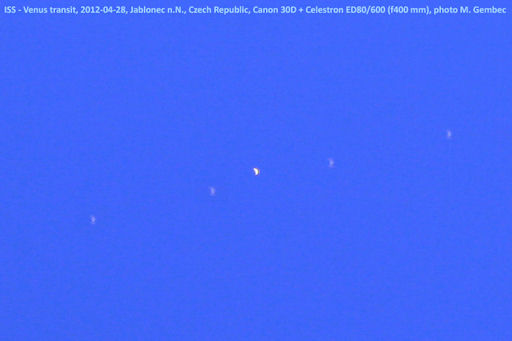MARS-DIRECTED CME: A minor CME that left the sun during the late hours of April 28th is heading for Mars. En route, it will sweep past the Mars Science Lab spacecraft, which is carrying Curiosity to the Red Planet. According to a forecast track prepared by analysts at the GSFC, the cloud will reach the rover on May 4th. Fortunately, Curiosity is equipped to sense and study solar storms: video.
VENUS IN BROAD DAYLIGHT: The brightest planet in the solar system is reaching its peak luminosity. On April 30th, Venus will shine at astronomical magnitude -4.7. That's 190 times brighter than a 1st magnitude star, bright enough to see in broad daylight if your eye lands right on it.
Yesterday in the Czech Republic, something drew Martin Gembec's eye directly to Venus. His guide was the International Space Station:
"We had a nice sunny afternoon picnic here in Jablonec," says Gembec. "In the clear blue sky overhead, the ISS went right through Venus. It was a special moment."
No ISS? No problem. Even without a spaceship, you can find Venus by looking 40° (about four fist-widths) east of the sun. Observing tip: Stand in the shadow of a tall building. You can also wait until the sun goes down. Venus is terrifically brilliant in the western twilight.
more images: from Aaron Top of Shallow Lake, Ontario, Canada

![]()
Solar wind
speed: 375.5 km/sec
density: 0.0 protons/cm3
explanation | more data
Updated: Today at 1713 UT
![]()
X-ray Solar Flares
6-hr max: C1 1432 UT Apr29
24-hr: C1 0055 UT Apr29
explanation | more data
Updated: Today at: 1700 UT
![]()
![]()
![]()
Daily Sun: 29 Apr 12
![]()
![]()
Sunspot 1465 has a 'beta-gamma' magnetic field that harbors energy for M-flares. Nevertheless, solar activity is low. Credit: SDO/HMI
![]()
![]()
![]()
Sunspot number: 118
What is the sunspot number?
Updated 28 Apr 2012
Spotless Days
Current Stretch: 0 days
2012 total: 0 days (0%)
2011 total: 2 days (<1%)
2010 total: 51 days (14%)
2009 total: 260 days (71%)
Since 2004: 821 days
Typical Solar Min: 486 days
Updated 28 Apr 2012
The Radio Sun
10.7 cm flux: 121 sfu
explanation | more data
Updated 28 Apr 2012
![]()
![]()
![]()
Current Auroral Oval:
![]()
Switch to: Europe, USA, New Zealand, Antarctica
Credit: NOAA/POES
![]()
![]()
![]()
Planetary K-index
Now: Kp= 1 quiet
24-hr max: Kp= 2 quiet
explanation | more data
![]()
Interplanetary Mag. Field
Btotal: 3.2 nT
Bz: 2.7 nT south
explanation | more data
Updated: Today at 1726 UT
![]()
![]()
![]()
Coronal Holes: 29 Apr 12
![]()
![]()
There are no large coronal holes on the Earthside of the sun. Credit: SDO/AIA.





